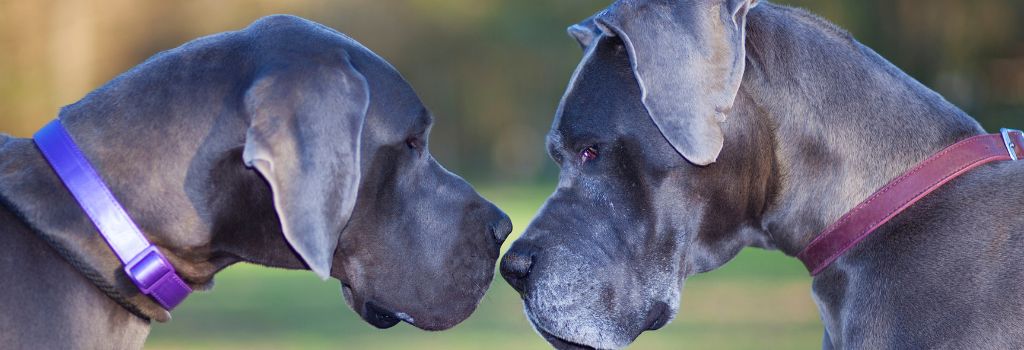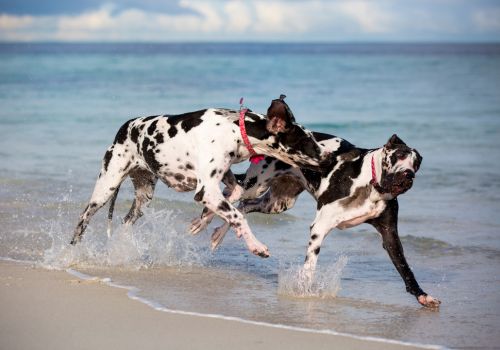Standing tall and magnificent, the Great Dane is a towering presence with a heart to match. These towering dogs may look intimidating at first glance, but they’re known for their affectionate nature, loyal temperament, and strong bond with their families. If you're searching for a large dog breed with a sweet heart and a watchful eye, the Great Dane may be the perfect fit.
Why Great Danes Make Great Family Dogs
Great Danes are affectionate, patient, and good-natured, which makes them a great choice for families with children. Despite their size, they are typically gentle around kids and thrive when included in daily family activities. They’re also known for being playful, social, and eager to please—traits that make training more enjoyable and bonding easier.
As natural protectors, Great Danes are alert and confident. Their deep bark and imposing size can serve as a strong deterrent to intruders, but they’re far from aggressive by default. With the right socialization, great danes strike a perfect balance between being loyal watchdogs and loving companions.
Great Danes are also athletic and energetic. They enjoy outdoor play, long walks, and spending time with their humans. While they don’t require excessive exercise, daily activity is essential to keep them healthy and happy.
Great Dane Personality Traits and Challenges
Like all dog breeds, Great Danes come with their quirks. Due to their large size, they need plenty of space—and yes, you’ll probably notice some drool and gas here and there. Young Great Danes can be particularly rambunctious, often unaware of just how big they are, so early training is important to helping them learn polite manners.
Because they’re deeply bonded to their families, great danes don’t like being left alone for long periods. Without enough attention, stimulation, and proper training, they may become anxious or even destructive. Socializing your Great Dane early in life is really important to help them grow into a confident, well-adjusted adult dog.
The History of Great Danes
The Great Dane breed originated in Germany over 400 years ago. Bred to hunt wild boar and protect estates, they were a mix of Irish Wolfhound and Old English Mastiff. Known in some circles as the "German Mastiff," these dogs have long held a noble reputation. Over time, their role shifted from fierce hunters to family pets.
Today, they’re celebrated for their gentle temperament, loyalty, and undeniable presence. Though they look regal and serious, Great Danes are famously affectionate, often leaning on their humans (literally) for comfort and love.

Genetic Predispositions for Great Danes
Bloat
Oh, the Great Dane! This large breed is at risk for a rather scary condition known as bloat, or Gastric Dilatation and Volvulus (GDV) in medical terms. Imagine your dog's stomach filling up with gas and twisting on itself like a balloon animal gone wrong. It’s as painful and dangerous as it sounds, cutting off blood supply and becoming fatal in as little as 30 minutes. Signs include restlessness, retching with no vomit, an enlarged abdomen, and sometimes a "prayer position" (front down, rear up). The good news? There's a preventive surgery that can help. But if you see these signs, rush to the nearest emergency hospital—every second counts.
Heart Disease
Great Danes can be true gentle giants, but their hearts, unfortunately, aren't always as sturdy as their demeanor. Dilated cardiomyopathy (DCM) makes their hearts large, weak, and inefficient. Watch for fatigue, fainting, labored breathing, or coughing. Annual heart screenings can be life-saving, and medications can help your Dane enjoy many more tail-wagging years ahead.
Cancer
Cancer is serious, and Great Danes are particularly vulnerable. Watch for lumps, bumps, and changes in behavior. Osteosarcoma (bone cancer) often affects Danes, leading to lameness and pain. Then there's lymphoma, a blood cancer that's usually treatable but costly. Hemangiosarcoma, a bleeding tumor usually found in the spleen, is often detected too late. But regular veterinary exams, including blood tests and ultrasounds, can offer early detection and better outcomes.
Bone and Joint Woes: Growing Pains and Beyond
Those long, gorgeous legs of your Great Dane can sometimes be the source of pain. Whether it's osteochondritis dissecans (OCD), a condition where cartilage fails to attach correctly to the bone, or Panosteitis, which is characterized by inflammation, require proactive management. Timely intervention can change outcomes significantly! Whether through pain relief medications or surgery to resolve a joint problem. It's important to avoid overfeeding and rapid growth, as these factors can worsen these conditions. Be sure to follow your veterinarian's recommended diet plan for your great dane.

Neurological Issues
Have you ever noticed your Great Dane wobbling or stumbling as if he's slightly intoxicated? He might be experiencing Wobbler Disease, a condition that constricts the neck vertebrae and compresses the spinal cord. This interferes with the nerve signals to the brain, impacting your dog's balance. A variety of treatments, including medications, neck braces, and surgery, can help your great dane develop a better stability in life.
Eye Problems
Your Dane's eyes are windows to his soul and also a potential area for health concerns. From genetic disorders to acquired issues, many can result in painful complications or even blindness. This is why eye assessments are essential during every veterinary checkup. Be vigilant for any unusual symptoms, and don't hesitate to consult your veterinarian.
Addison's Disease
You might have heard of Addison's Disease from medical dramas on TV, but did you know your Great Dane could be at risk too? This condition affects your dog's adrenal glands, preventing them from producing hormones correctly. This disruption can lead to a dangerous situation if not addressed promptly. The symptoms are often ambiguous, resembling those of other health issues. However, there's no need to be alarmed! A specialized blood test can definitively identify this problem. Your veterinarian will monitor for symptoms during every exam and regularly assess electrolyte levels to ensure your pet's safety.
Hemolytic Anemia and Thrombocytopenia
Imagine your Great Dane's immune system getting too enthusiastic and attacking his red blood cells and platelets. This could lead to anemia, making your Dane weak, lethargic, and pale in the gums. Or, it might result in abnormal bleeding and bruising if platelets are destroyed. To keep a handle on this, we’ll run clotting tests especially before any surgery, and medications like steroids can often keep this self-destructive behavior in check. In critical cases, a transfusion might be a lifesaver.

Thyroid Problems: A Common Concern
A seemingly small hormone imbalance in your Great Dane may lead to problems such as dry skin, weight gain, or behavioral changes. It’s called hypothyroidism, and it’s fairly common in Danes. Good news: an annual blood screening can catch this early, and it’s generally as easy to manage as giving your pup a daily pill.
Allergies
If your Dane is licking his paws incessantly, has frequent ear infections, or is constantly rubbing his face, he might be dealing with allergies, or "atopy" to get technical. Dogs experience allergies differently than humans; while we might sneeze or rub our eyes, a dog's allergies often appear as itchiness in their paws, ears, or belly. The good news is that there are different types of treatment options to help soothe your pet's skin and rescue them from allergies.
Mange: Mighty Mites
Demodex mites: we all have them, even our dogs. But Great Danes may find it challenging to manage these uninvited guests, resulting in annoying hairless spots on their skin. Although some dogs outgrow this issue, others require continuous treatment. Timely veterinary intervention is important to stop this condition from worsening.
Paw Infections
Ever seen your Great Dane limping or incessantly licking his paws? He could be dealing with pododermatitis, a painful skin infection between the toes. This condition seems to love dogs with allergies, so a check-up is in order if you notice any redness or inflammation. You wouldn’t want to walk on sore feet, and neither does your dog!
Dental Difficulties
Braces aren't just for teenagers anymore; even your Great Dane might need them! Dental abnormalities like malocclusion (a bad bite) or oligodontia (having too few teeth) are not just cosmetic issues. They can cause real problems for your Dane. But don't worry! Whether it’s braces or tooth extractions, we're here to help resolve these issues before they impact your dog's life.
If you have questions and you'd like to reach out to us, you can call us directly at (859) 625-5678, or you can email us at [email protected]. Don't forget to follow us on social media Facebook, Instagram.
